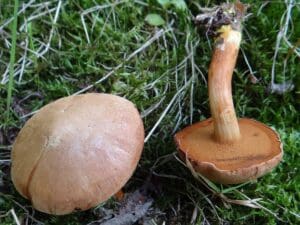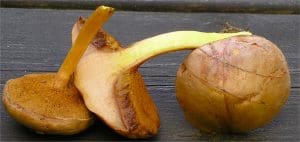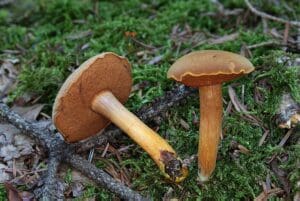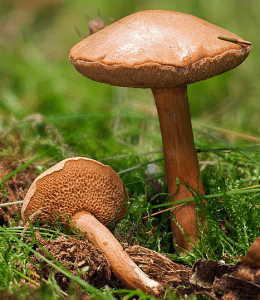Peppery Bolete / Summer / Autumn / Edible
The Peppery Bolete Mushroom illuded me for a little while until I went on a mushroom mad trip to Scotland for a week where I was camping out in the forest and almost completely immersed in the wild world and specifically fungi.
It’s surprisingly small, but what it lacks in size it makes up for in its spicy peppery flavour.
The Pepper Bolete mushroom (Chalciporus piperatus) is a hidden gem for mushroom enthusiasts. Foraging for these small, reddish-brown caps amidst the forest floor feels like finding spicy little treasures. Unlike more common mushrooms, the Pepper Bolete has a distinct peppery bite that adds a delightful heat to dishes.
Whether sautéed with butter or added to a hearty stew, its unique flavor shines through, offering a wild twist to home-cooked meals. It’s a favorite for those who enjoy experimenting with foraged ingredients, turning humble meals into something truly adventurous and bold.
Common names
Peppery bolete
Scientific Name
Chalciporus piperatus
Family
Boletaceae
Habitat
Mixed deciduous woodland particularly Birch
If you see a peppery bolete then the Fly Agaric or certainly the mycelium is nearby as it is parasitic on it. Fairly common in the UK
Late summer to autumn
Peppery Bolete Foraging Video
Description
A small bolete with a unique peppery flavour, not initially striking in appearance, except for the bright chrome yellow coloured flesh of the stem which is a key identifying feature.
Identifying Features of the Peppery Bolete
Cap:
Cinnamon brown, 2-8 cm Hemispherical and becoming convex then flatter with age. Can have a light sheen.

Stem:
The stem (stipe) 2-10cm long and usually crooked. At the base the stem Tapers and is bright chrome yellow.

Flesh:
Yellow in the stem, with more red tones in the cap.
Flesh is unchanging when bruised
Underside (fertile)
This is a polypore fungi, lots of pores (holes) looking much like sponge on the underside of the cap. The pores are a similar cinnamon colour to the cap and large and angular in shape.
The pores (visible) are the end of tubes, which you can see if you cut a cross section of the cap. A feature of all boletes is that you can gently peel the pore layer away from the cap.

Smell:
No distinguishable smell
Taste: hot and peppery
Spores:
brown
Known hazards
If you are sensitive to chilli you may also be sensitive to the peppery bolete so try a small amount first.
Potential lookalikes
No poisonous look-a-likes
A few other small boletes look similar none of which are toxic
The rare parasitic bolete Pseudoboletus parasiticus which is edible but should not be picked, easy to differentiate as it is visably growing off the side of common Earthballs.
Also could be confused with C. hydopochryseus and C. amarellus which too are rare and edible.
Potentially matt boletes which are much darker and matt on top
Uses
In food
Fantastic find to add some hot peppery seasoning to your dish, can be added directly or the best way is to dry and powder this mushroom and use as seasoning. The heat can take a little time to come through so use sparingly at first. Comparable to medium chillis.
Great added to mayonnaise!
Here are five of my favourite recipe ideas that utilise the Peppery Bolete mushroom:
- Pepper Bolete and Wild Herb Risotto
Sauté Pepper Bolete mushrooms with wild herbs, garlic, and shallots, then stir them into a creamy risotto. The peppery notes balance beautifully with the richness of the Parmesan. - Pepper Bolete and Sausage Stuffed Peppers
Mix sautéed Pepper Bolete mushrooms with spicy sausage, rice, and cheese, then stuff the mixture into bell peppers. Roast until tender for a hearty, savoury dish. - Pepper Bolete Mushroom and Potato Hash
Combine Pepper Bolete mushrooms with crispy potatoes, onions, and fresh herbs for a rustic hash. Top with fried eggs for a perfect brunch or breakfast-for-dinner meal. - Pepper Bolete and Beef Stroganoff
Add a twist to the classic beef stroganoff by incorporating Pepper Bolete mushrooms. Their heat complements the creamy sauce, adding depth and complexity to the dish. - Spicy Pepper Bolete Mushroom Soup
Simmer Pepper Bolete mushrooms with leeks, potatoes, and vegetable broth for a warming soup. Finish with a splash of cream to mellow the heat, creating a comforting yet bold flavour profile.
Resources
https://www.first-nature.com/fungi/leccinum-scabrum.php
Edible mushrooms by Geoff Dann






